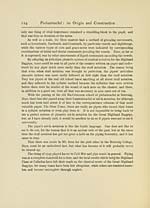Hew Morrison Collection > Piobaireachd
(129)
Download files
Complete book:
Individual page:
Thumbnail gallery: Grid view | List view

The Growth of Piobaireachd and its Preservation 123
hi-ei iedir-ie - i - i:i hi - ei, hiei-uha-uma iedir-ie - i - hei.
hiei-o - do - ro h
This illustration of translation works out in keeping with the Phonetic Vowel
Scale given on the previous page.
It will be observed in the first movement or group of notes in the fourth bar
that " b " is used as a grace-note between the first two notes, and " um " is taken
as the second G grace-note because it gets more time value than the first G, and
this produces the actual sound of the chanter. By using the letter " b " as the
grace-note in the B B B and DBA movements the closing and opening of the
chanter is reproduced in the syllabic notation.
Apart altogether from a system of notation the canntaireachd will never die
out. It is still crooned by the father to the son as it was in the days of the Mac-
Crimmons. It is the music of the piob mhor transformed into the language that
will always make the pulse beat faster where the blood is purely Celtic, and tune
those tender chords in perfect harmony where the heart is truly Highland.
One may sing a scale in the same syllable from beginning to end, such as : —
C DEFGA BC
Lah. Lah. Lah. Lah. Lah. Lah. Lah. Lah.
But, as already indicated, there was something more in the real MacCrimmon scale
and notation than the tonic sol-fa or single syllable.
If the MacCrimmon scale and sol-fa or syllabic notation was to be of any use
at all it must have been phonetic. The tunes which they composed were sung over
or chanted, giving each note and movement in an articulate method. They named
their system of notation " Canntaireachd," because canntaireachd means to chant,
and the instrument which was chosen by the Highlander to play his music on was
named a " Chgjiter," because it produced the sounds which the old masters chanted
or sung when composing tunes and teaching their pupils.
The MacCrimmon music was produced articulately to represent the exact
phonetic sound of the notes or movements on the chanter, this being so,
hi-ei iedir-ie - i - i:i hi - ei, hiei-uha-uma iedir-ie - i - hei.
hiei-o - do - ro h
This illustration of translation works out in keeping with the Phonetic Vowel
Scale given on the previous page.
It will be observed in the first movement or group of notes in the fourth bar
that " b " is used as a grace-note between the first two notes, and " um " is taken
as the second G grace-note because it gets more time value than the first G, and
this produces the actual sound of the chanter. By using the letter " b " as the
grace-note in the B B B and DBA movements the closing and opening of the
chanter is reproduced in the syllabic notation.
Apart altogether from a system of notation the canntaireachd will never die
out. It is still crooned by the father to the son as it was in the days of the Mac-
Crimmons. It is the music of the piob mhor transformed into the language that
will always make the pulse beat faster where the blood is purely Celtic, and tune
those tender chords in perfect harmony where the heart is truly Highland.
One may sing a scale in the same syllable from beginning to end, such as : —
C DEFGA BC
Lah. Lah. Lah. Lah. Lah. Lah. Lah. Lah.
But, as already indicated, there was something more in the real MacCrimmon scale
and notation than the tonic sol-fa or single syllable.
If the MacCrimmon scale and sol-fa or syllabic notation was to be of any use
at all it must have been phonetic. The tunes which they composed were sung over
or chanted, giving each note and movement in an articulate method. They named
their system of notation " Canntaireachd," because canntaireachd means to chant,
and the instrument which was chosen by the Highlander to play his music on was
named a " Chgjiter," because it produced the sounds which the old masters chanted
or sung when composing tunes and teaching their pupils.
The MacCrimmon music was produced articulately to represent the exact
phonetic sound of the notes or movements on the chanter, this being so,
Set display mode to: Large image | Transcription
Images and transcriptions on this page, including medium image downloads, may be used under the Creative Commons Attribution 4.0 International Licence unless otherwise stated. ![]()
| Early Gaelic Book Collections > Hew Morrison Collection > Piobaireachd > (129) |
|---|
| Permanent URL | https://digital.nls.uk/81165465 |
|---|
| Description | A selection of items from a collection of 320 volumes and 30 pamphlets of literary and religious works in Scottish Gaelic. From the personal library of Hew Morrison, the first City Librarian of Edinburgh. |
|---|
| Description | Selected items from five 'Special and Named Printed Collections'. Includes books in Gaelic and other Celtic languages, works about the Gaels, their languages, literature, culture and history. |
|---|

